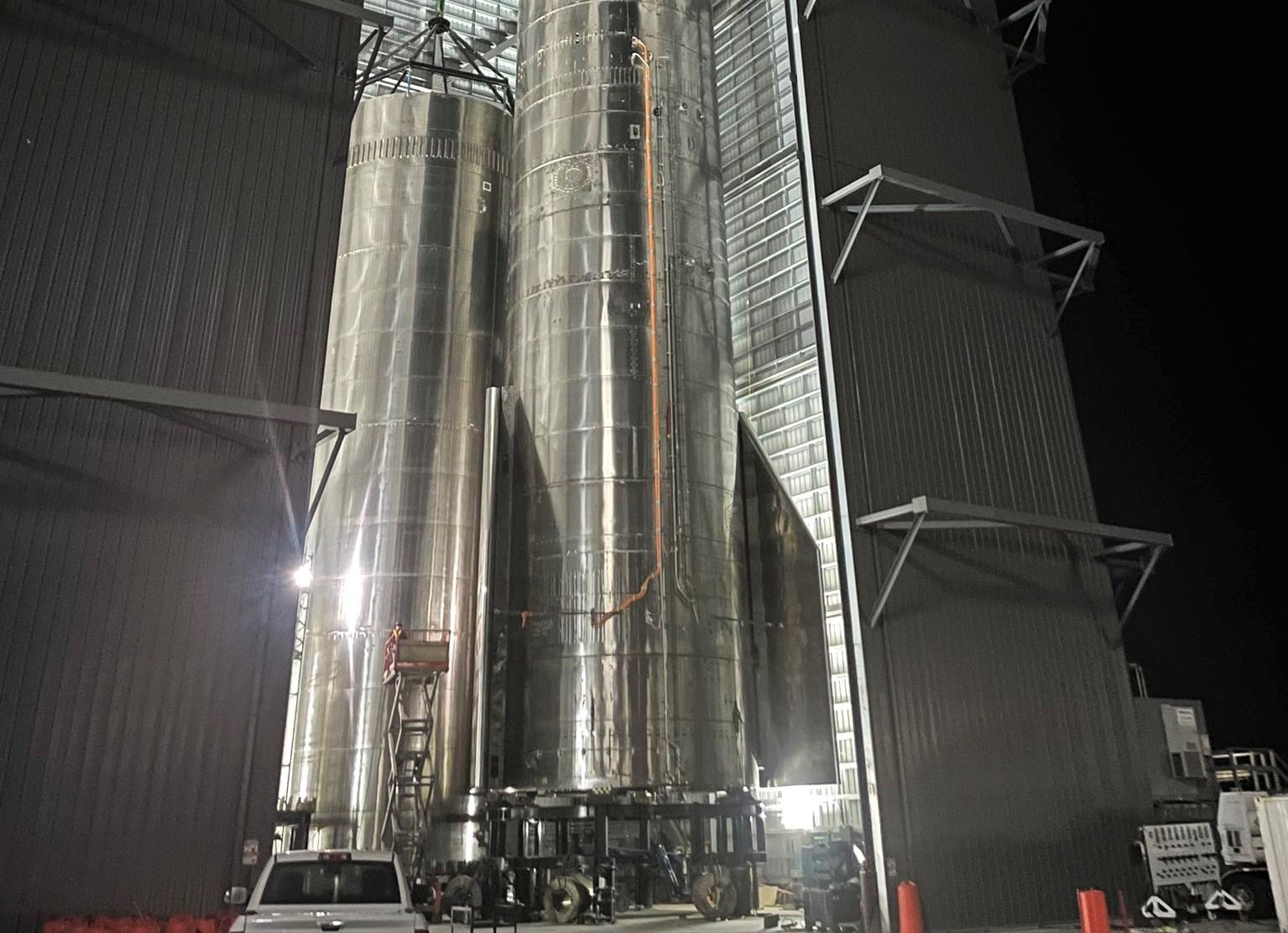

News
Elon Musk says SpaceX’s second Starship booster prototype is almost finished
SpaceX CEO Elon Musk says that the second Starship booster prototype is “almost done” and has revealed that work on the first flightworthy booster has yet to begin.
For unknown reasons, SpaceX has recently changed the naming scheme for Starship and Super Heavy boosters. The booster SpaceX is currently assembling in Boca Chica has been referred to as “Booster 2” by Musk himself but, according to NASASpaceflight, is internally known as Booster 3 or B3, replacing its former Booster Number 3 (BN3) designation.
Regardless, SpaceX began stacking the Super Heavy booster prototype now known as B3 in mid-May. Around six weeks later, 23 or 24 rings have been stacked to create a partially finished prototype 9m (~30 ft) wide and approximately 42m (~140 ft) tall.
Just like Super Heavy ‘pathfinder’ BN1, which was scrapped almost the instant it reached its full height last March, Booster 3 appears to destined to stand 36 rings – 65m (~215 ft) – tall once complete. While drastically oversimplifying the process of vertically assembling the largest rocket booster ever built, that means that Super Heavy B3 is just shy of two-thirds (~65%) complete.
By simply averaging the time it’s taken for SpaceX to stack B3 to a height of 42 meters, the booster could reach its full height around three weeks from now (July 15th, give or take a week). For the most part, the most challenging and unfamiliar parts of Super Heavy B3 manufacturing and assembly have already been completed. Relative to Starship, which SpaceX has now built more than half a dozen prototypes of, Super Heavy is just a stretched Starship with no flaps, no nosecone, a far more complex engine section, and a forward dome section that needs to support car-sized grid fins.
Super Heavy’s larger propellant tanks also require a methane transfer tube – used to carry methane through the booster’s lower liquid oxygen tank – more than twice as tall as anything built for Starship. By all appearances, that ~35m (~115 ft) tall transfer tube has already been safely installed inside B3’s incomplete tanks. Around June 14th, B3’s lower two-thirds were effectively completed when its LOx tank stack was mated to the booster’s 29-Raptor engine section.
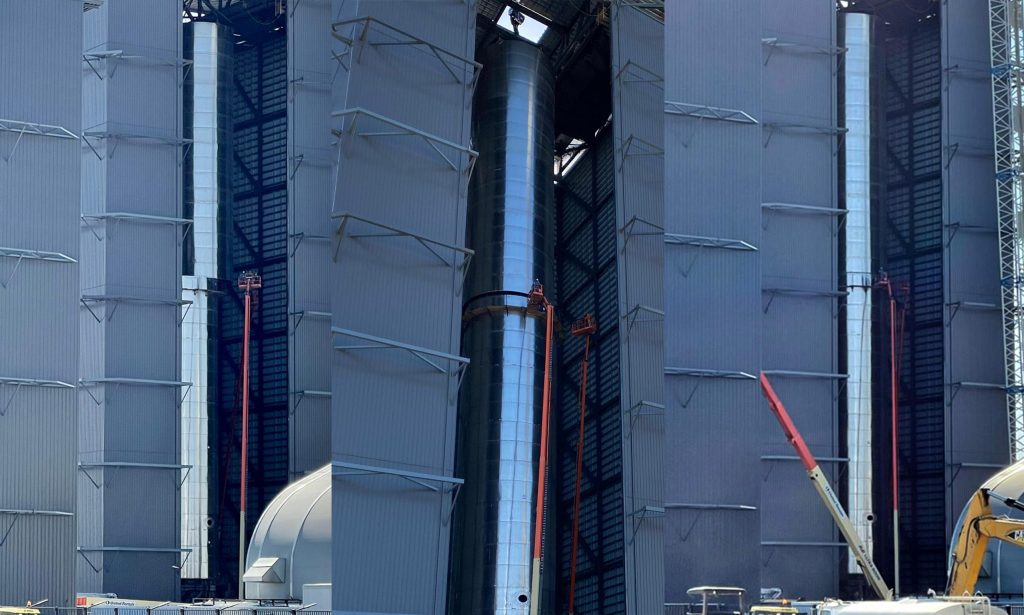
Outfitted with complex structural modifications to support massive grid fins and the first advanced ‘hot gas’ maneuvering thrusters ever spotted in public, Booster 3’s forward dome is already in the process of being welded to a stack of three steel rings. Once complete, the rest of Super Heavy B3 integration is fairly simple as far as rocket assembly goes and will require four more welding operations. Like BN1, there’s a good chance that SpaceX will mate Booster 3’s upper (methane) tank separately and then install the ~24m (~80 ft) tall, 13-ring section on top of the LOx stack to effectively complete the booster’s main structure
Of course, after the structure is complete, SpaceX will still need to finish plumbing, wiring, and generally outfitting a Super Heavy booster for the first time ever. Finally, while it remains to be seen just how finished B3 will actually find itself before heading to the launch pad, that process could also involve installing and testing four massive steel grid fins and, most importantly, up to 29 Raptor engines – a figure only beaten by the Soviet Union’s ill-fated N1 rocket.
Perhaps most significantly, Musk also revealed that B3 is not the Super Heavy booster assigned to Starship’s first orbital launch attempt, meaning that SpaceX will have to complete Booster 3 testing and build Booster 4 before that orbital test flight can occur. Given that Booster 3 assembly is on track to take more than nine weeks, Starship’s first orbital launch attempt is thus unlikely to happen before late August or September.
Elon Musk
Elon Musk confirms Grok 4 launch on July 9 with livestream event
The rollout will be accompanied by a livestream at 8 p.m. Pacific Time.
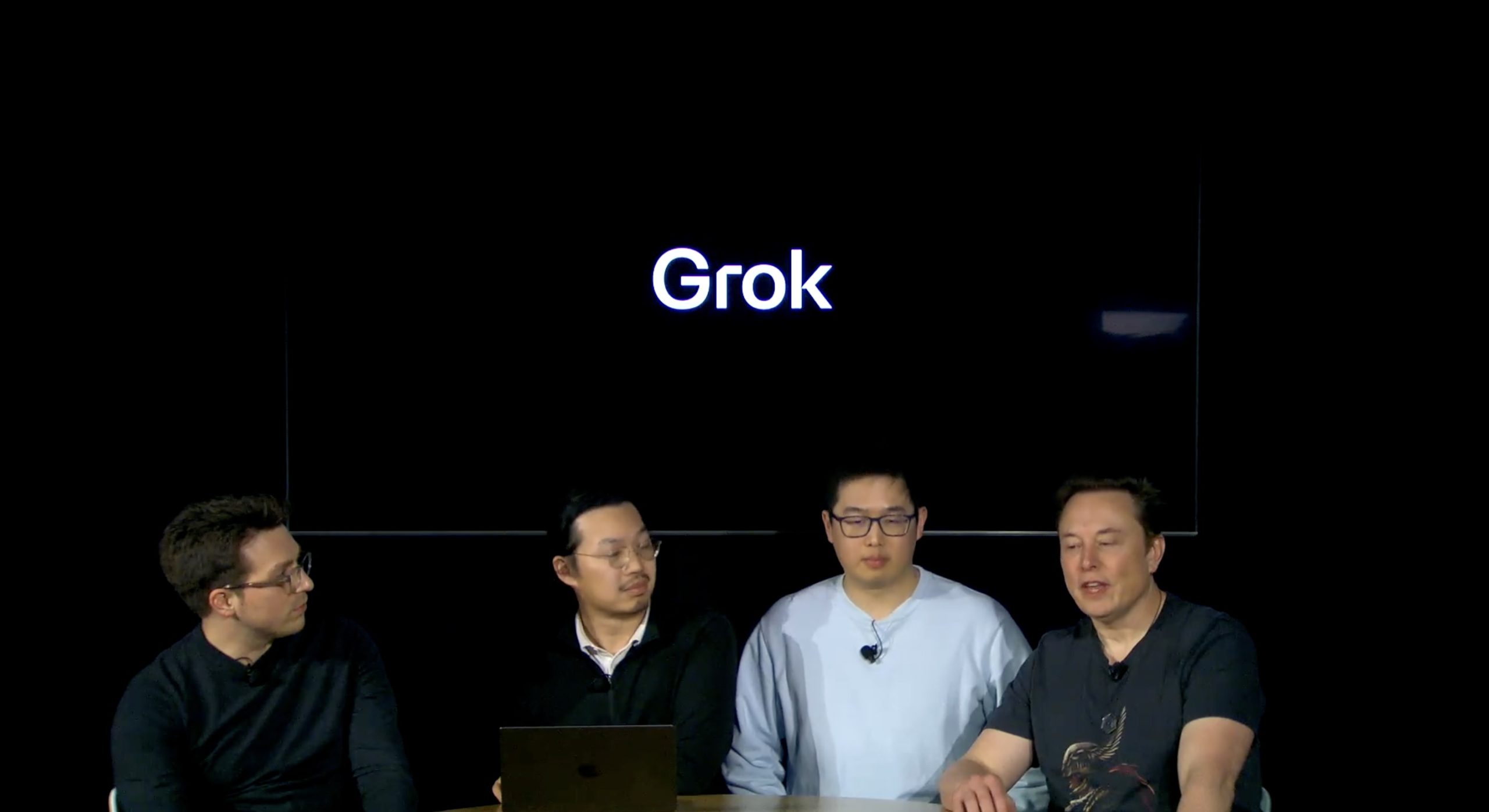
Elon Musk has officially confirmed that Grok 4, the latest version of xAI’s large language model, will launch on July 9. The rollout will be accompanied by a livestream at 8 p.m. Pacific Time, hosted on xAI’s official account on X.
xAI goes straight to Grok 4
Back in May, leaks indicated that xAI was getting ready to ship Grok 3.5. Considering Musk’s recent comments, however, it appears that the artificial intelligence startup would be focusing on the large language model’s fourth iteration instead. As noted in a Financial Express report, users on X have sighted references to Grok 4 in the lead up to the update’s launch, such as “grok-4-prod-mimic” and “Grok 4 Code.”
Musk’s Grok 4 announcement comes as AI competition intensifies between major players including OpenAI, Google, and xAI. With Musk’s Colossus supercomputer fully operational in Memphis, xAI appears to be accelerating its AI product roadmap.
Musk pushes Grok toward political neutrality
Grok 4’s launch also follows a recent controversy involving political bias, as noted in a CNN report. Last week, Grok responded to a user on X stating that political violence in the U.S. since 2016 had come more from the political right than the left. The chatbot noted in a later reply that its answer was based on information from sources like Reuters, the Journal of Democracy, and University of Maryland studies.
Musk stated that Grok’s response was a “major fail.” “Major fail, as this is objectively false. Grok is parroting legacy media. Working on it,” he wrote in a post on X. By the end of June, Musk noted that he was “grinding all night with the xAI team” and that they were making “good progress.” He also stated that the model “Will be called Grok 4. Release just after July 4th. Needs one more big run for a specialized coding model.”
News
Tesla opens massive solar Supercharger station in California
The Supercharger opened to customers ahead of Fourth of July weekend, while Tesla continues phase two of construction on the site.
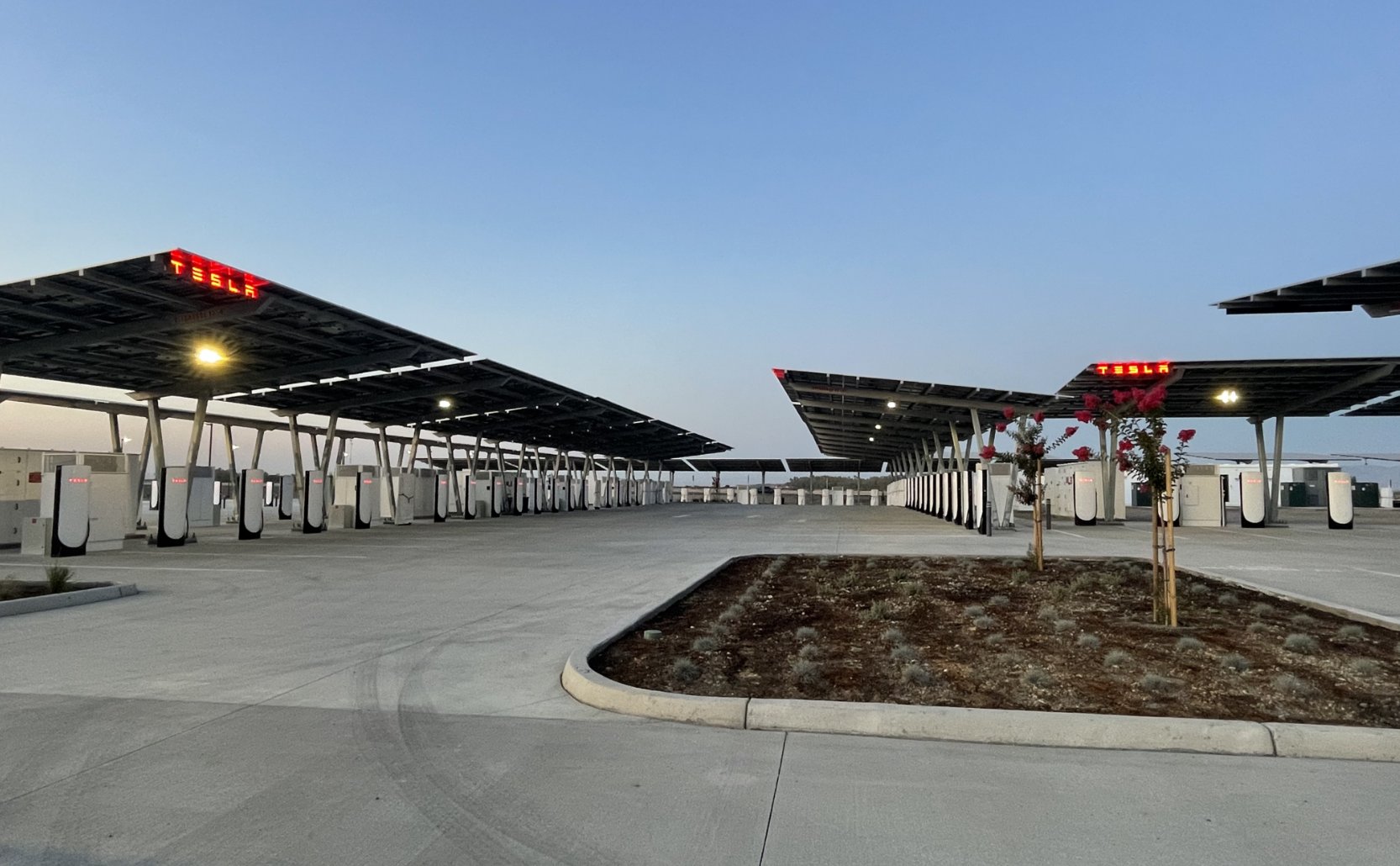
Tesla has officially launched the first several Supercharging posts at a massive station in California, notably including solar canopies and grid-scale batteries to offer completely renewable charging.
Last week, Tesla announced on X that it opened the first 84 Supercharger stalls of a planned 168-stall station in Lost Hills, California. Additionally, the massive Supercharger project features 11MW of solar canopies and 10 Megapack batteries for off-grid charging powered entirely by solar energy.
Tesla completed the first phase of the project just days ahead of the busy Fourth of July holiday weekend, adding that initial construction took just eight months. In addition to the remaining charging stalls, Tesla says it’s building a set of lounge areas, renderings of which can be seen below alongside current photos of the site.
Notably, the site also includes V4 charging posts for the company’s latest available charging speeds, and it’s located near the busy junction between I-5 and Highway 46 in Kern County.
“Thank you [Kern County] and [PG&E] for collaboration and approvals,” Tesla wrote in a follow-up post.
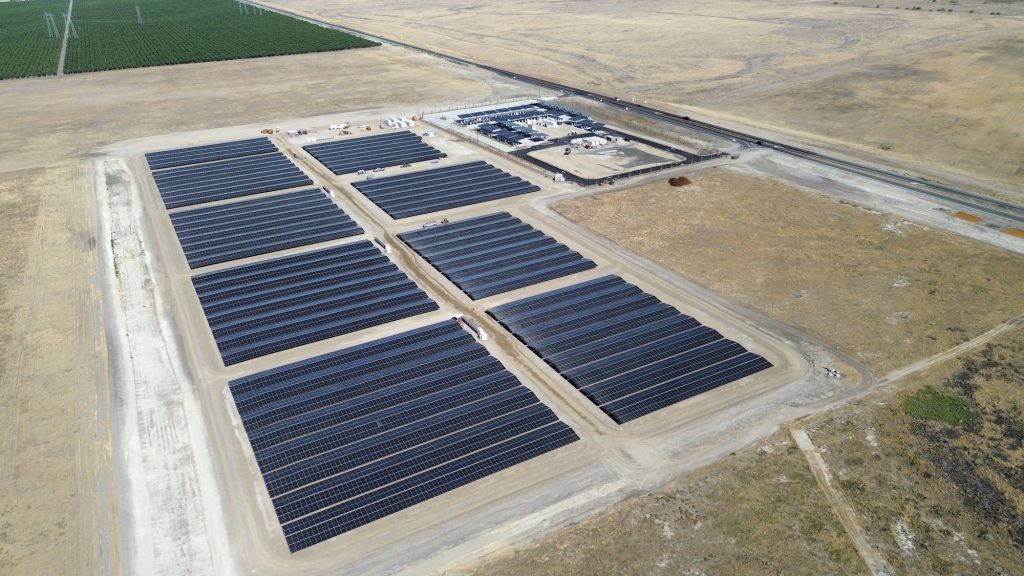
Credit: Tesla Charging | X
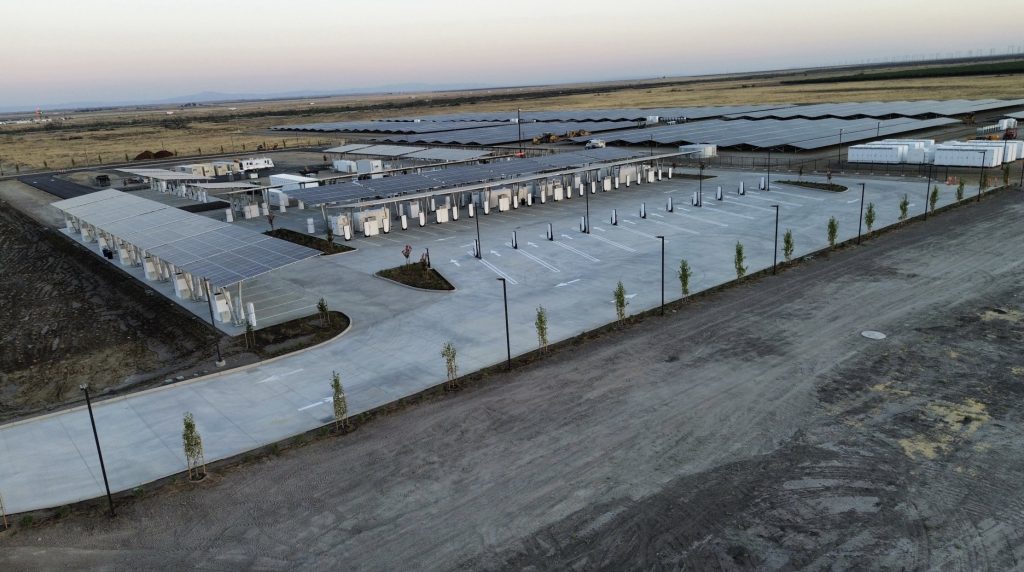
Credit: Tesla Charging | X
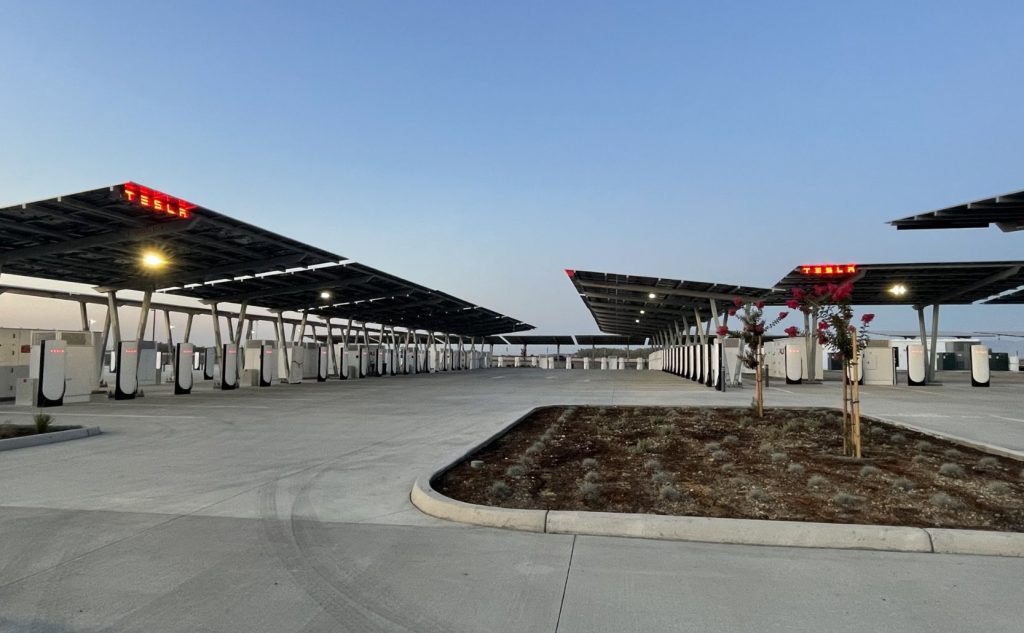
Credit: Tesla Charging | X
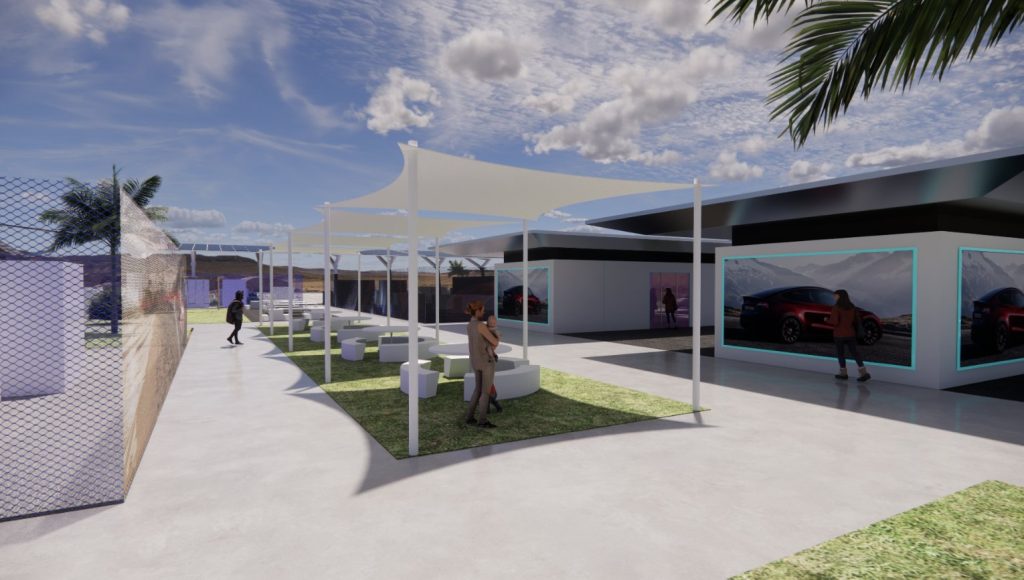
Credit: Tesla Charging | X
Tesla Supercharger Maps for North America, Europe, and Asia pic.twitter.com/0U5r0XRPyo
— TESLARATI (@Teslarati) July 2, 2025
READ MORE ON TESLA SUPERCHARGERS: Tesla launches ultra-fast V4 Superchargers in China for the first time
Testing at the LA Diner, plus Musk update on potential Tesla solar Gigafactory
The huge Tesla Supercharger station completed phase one of construction fairly quickly, especially given how long Tesla has been working on its unique Los Angeles diner, drive-in, and Supercharger location. Still, the company was seen performing some testing at the nearly-completed charging station earlier this month, and will reportedly be holding a job fair.
Elon Musk also responded on Monday morning to a post on X, suggesting that Tesla is “thinking about” building a U.S.-based solar Gigafactory in order to help support increased power needs with AI growth, and to bolster domestic solar production.
Tesla is building a new UFO-inspired Supercharger in the heart of Alien country
News
Tesla driver walks away from major accident with minor injuries
The driver sustained only minor injuries, and the exact cause of the crash remains under investigation.
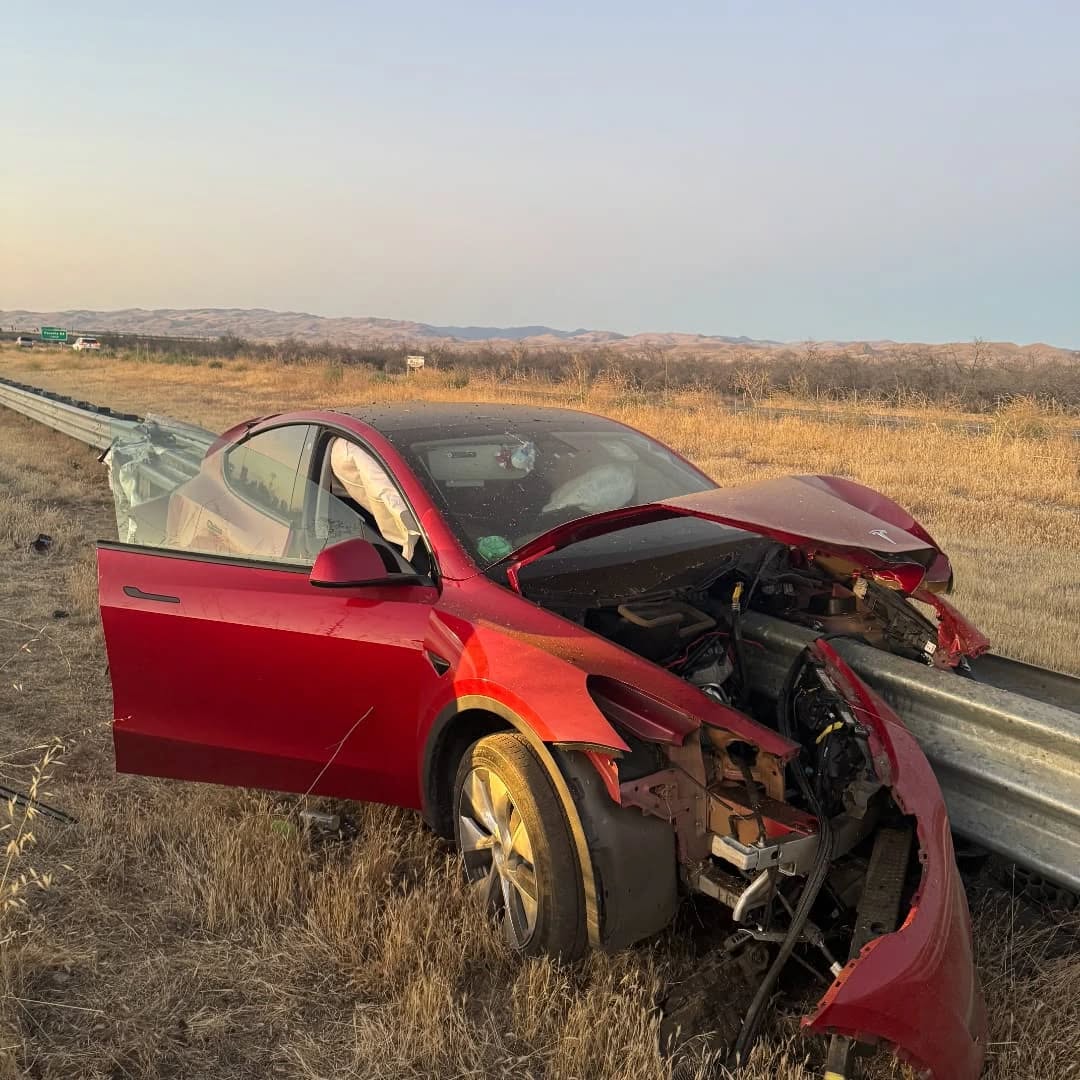
The driver of a Tesla Model Y survived and walked away from a harrowing accident on Monday in California, only sustaining minor injuries despite the vehicle being impaled by a guardrail.
On Monday morning around 4:34 a.m., the Los Banos division of the California Highway Patrol (CHP) responded to the accident on I-5 near Panoche Road, involving a 23-year-old in a Tesla Model Y. According to a post on social media, the driver veered off the road for unknown reasons in the northbound lane, before crashing directly into the guardrail and impaling the vehicle.
You can read the full message and photos from Los Banos CHP below, as were shared in a Facebook post on Monday afternoon.
This morning a Tesla model y was traveling in the #1 northbound lane of I-5 north of Panoche Rd. For unknown reasons driver allowed V-1 to veer off the roadway, travel through a dirt center divide, and crashed into the fixed metal guardrail. Lucky for the driver he only sustained minor injuries and was able to walk away. Driving a vehicle requires 100% attention to the road. Avoid distractions and focus on driving.
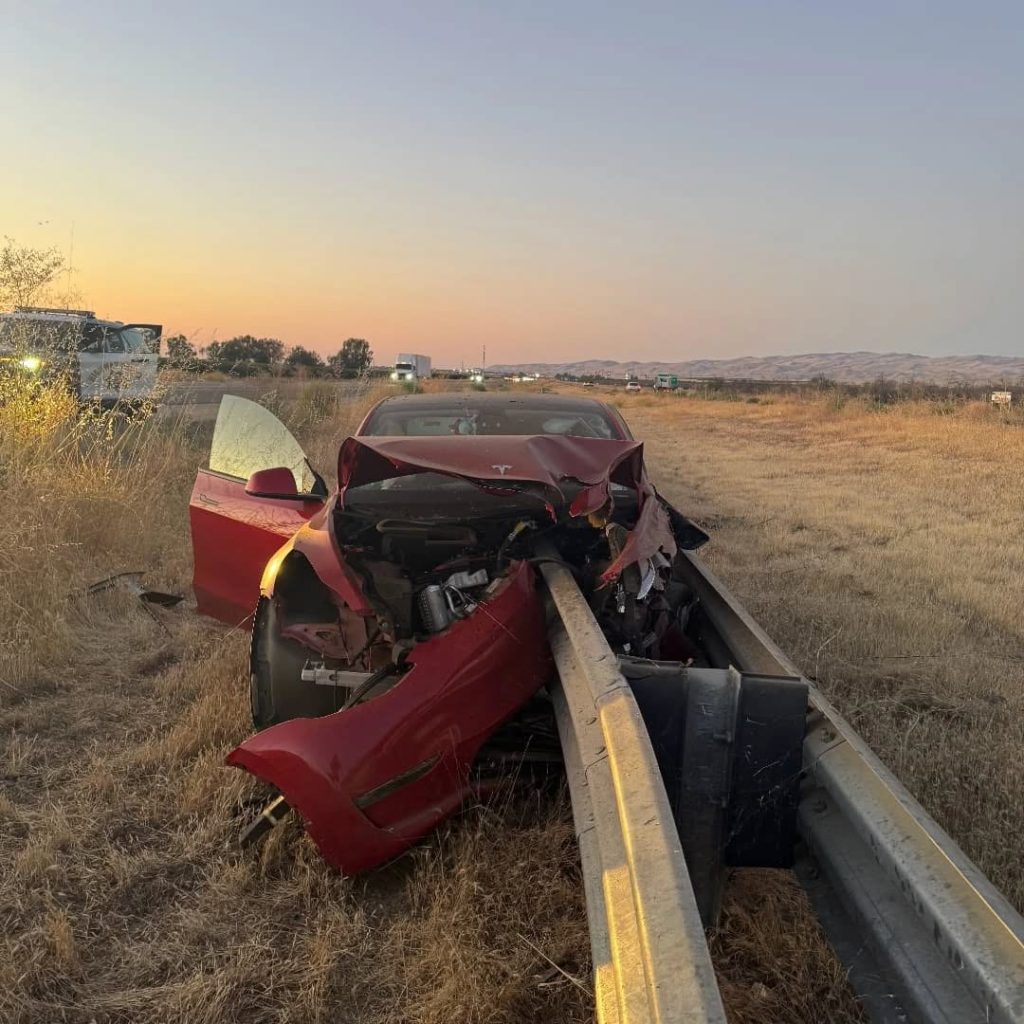
Credit: CHP Los Banos (via Facebook)
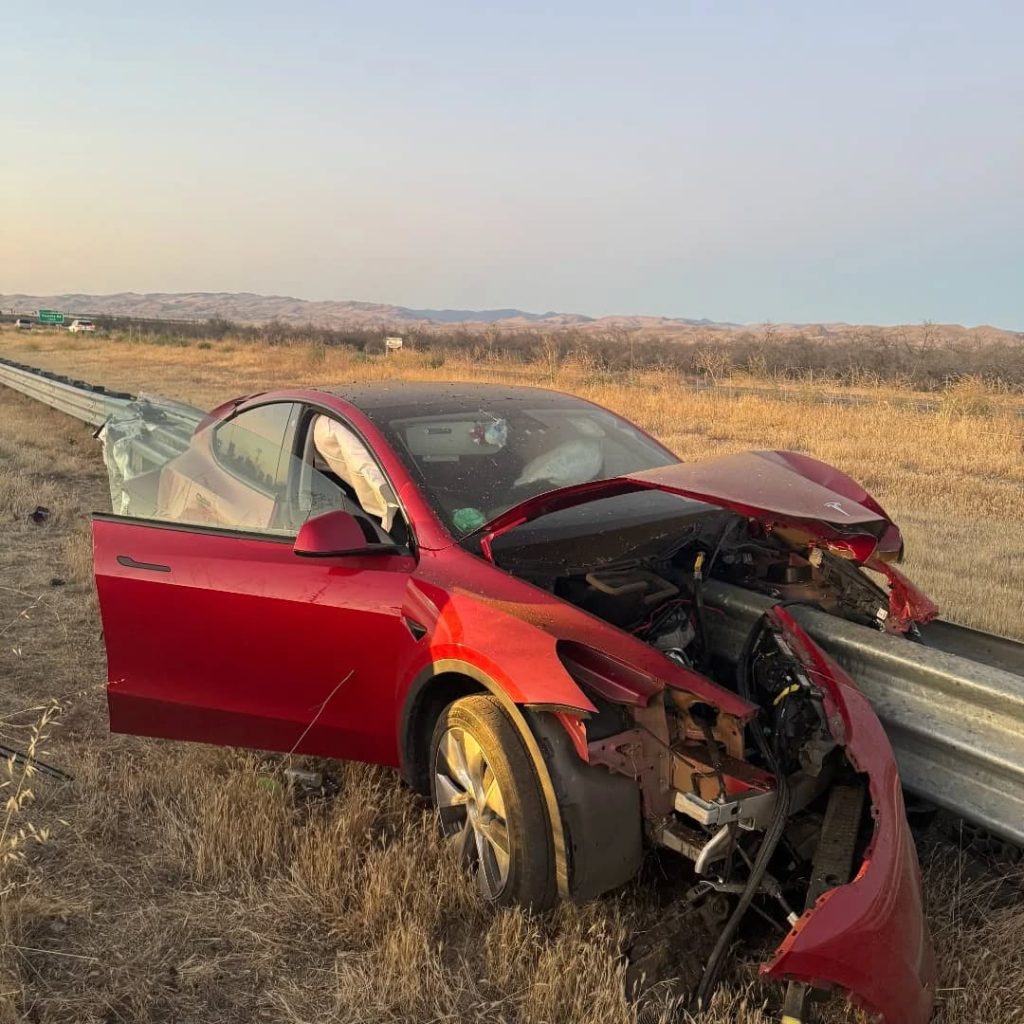
Credit: CHP Los Banos (via Facebook)
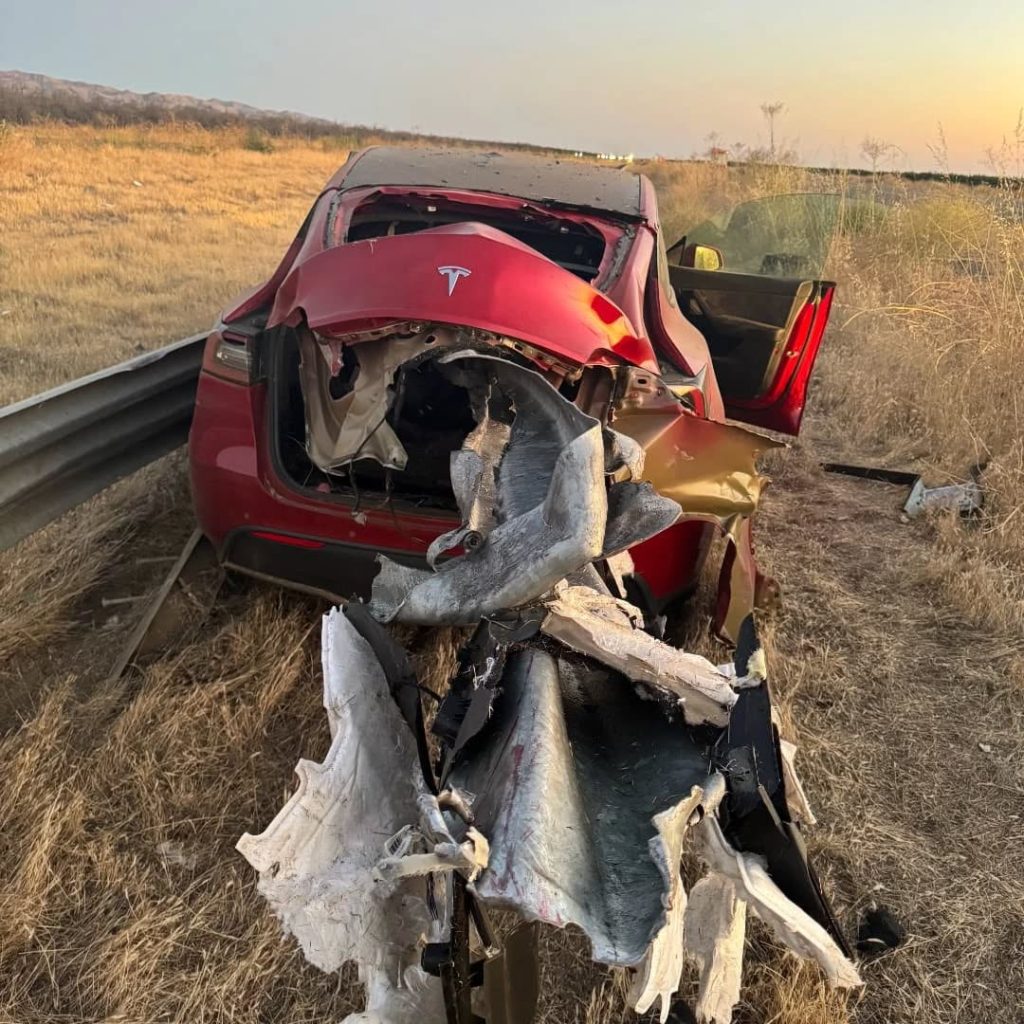
Credit: CHP Los Banos (via Facebook)
In a statement to SFGate, CHP officer Myles Anderson said that the driver only sustained minor injuries, while no arrests are made and drugs and alcohol are not suspected to have been involved. The report also notes that Tesla’s “cruise control and lane assistance features” were activated, according to Anderson. However, it’s not entirely clear if this is referring to Supervised Full Self-Driving (FSD), or to the cruise control and lane assist features baked into Autopilot.
At the time of writing, CHP has not yet responded to Teslarati’s request for clarification and additional details on the matter.
Tesla Crash Safety Ratings across its lineup: pic.twitter.com/ny30R7ceji
— TESLARATI (@Teslarati) July 1, 2025
READ MORE ON TESLA SAFETY: Tesla rolls out crucial new safety feature aimed at saving children
The news comes after Tesla has touted its vehicles as incredibly safe for many years. In December, for example, the company highlighted receiving top safety scores from regulators on four different continents throughout the world, including from the National Highway Traffic Safety Administration (NHTSA) and the Insurance Institute of Highway Safety (IIHS) in the U.S.
Tesla has also listed the goal of making its vehicles the safest on the road throughout the years, both in the overall design of its vehicles and in its Autopilot and Full Self-Driving (FSD) programs.
Tesla Model 3 ranks as the safest new car in Europe for 2025, per Euro NCAP tests
-

 Elon Musk1 week ago
Elon Musk1 week agoTesla investors will be shocked by Jim Cramer’s latest assessment
-

 News2 weeks ago
News2 weeks agoTesla Robotaxi’s biggest challenge seems to be this one thing
-

 News2 weeks ago
News2 weeks agoWatch the first true Tesla Robotaxi intervention by safety monitor
-

 Elon Musk2 weeks ago
Elon Musk2 weeks agoA Tesla just delivered itself to a customer autonomously, Elon Musk confirms
-

 News2 weeks ago
News2 weeks agoTesla Robotaxi rollout proves that Elon Musk still delivers, even if it’s late
-

 Elon Musk2 weeks ago
Elon Musk2 weeks agoxAI welcomes Memphis pollution results, environmental groups push back
-
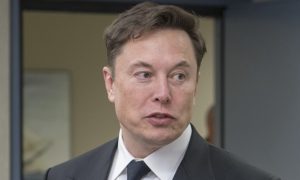
 Elon Musk2 weeks ago
Elon Musk2 weeks agoElon Musk commends Tesla team on successful Robotaxi launch
-

 Elon Musk2 weeks ago
Elon Musk2 weeks agoElon Musk confirms Tesla Optimus V3 already uses Grok voice AI


















